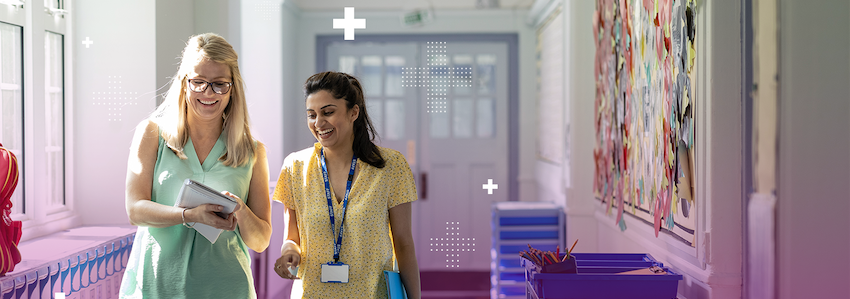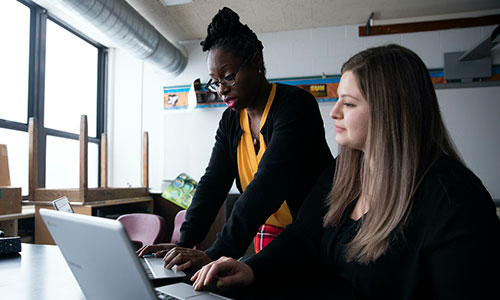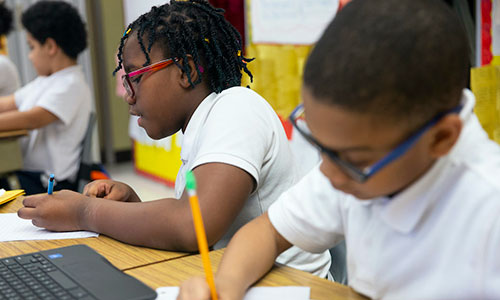
I admit it: in meetings, I’m that person. I often fidget, stand in the back, and check my watch more than necessary. It’s not that I’m not interested in the content or what my colleagues have to share. Quite the opposite. It’s that I have so much else to do.
Since time is the most precious non-renewable resource I have as an educator, I need meetings and learning experiences that are deeply engaging and well-structured so that I can feel like my time is being used as effectively and efficiently as possible. Protocols can help with that.
Why protocols help
As Lois Brown Easton explains in “Protocols: A facilitator’s best friend,” “In the field of education, protocols are simply an agreed upon set of guidelines for conversation. They are a code of behavior, a modus operandi, for groups to use when exploring ideas.”
I still remember my first experience using a protocol more than a decade ago. While sitting with a group of instructional coaches in a book study on Jim Knight’s High Impact Instruction: A Framework for Great Teaching, the facilitator introduced the Four “A”s Text Protocol from School Reform Initiative. I was the most novice member of the group (and am an introvert at heart), so leaping into conversation about the text would not have been my natural approach. The protocol provided each of us the opportunity to share, reflect, and build off each other’s ideas, however, so I was nudged to jump in.
By using this protocol, we all made personal connections to the text (which I still remember to this day!) while sharing our thoughts equally and without interruption. I thought to myself, “Wow! I learned a lot!” as I left our meeting with a newfound confidence in my own voice as a budding coach.
In many meetings, things don’t go quite as smoothly. A conversation can go around in circles without any tangible results. Or, when a conversation is dominated by one or two speakers, the rest of the group may feel that their opinions are not considered and, therefore, they do not contribute actively. A protocol can safeguard against conversations going awry or getting off track. Protocols set the stage for the form and function of learning new content, exploring ideas, and solving shared problems in a healthy, collaborative environment.
How to use protocols
At NWEA, we often use protocols in our own professional learning experiences, not only to explore data or dig deeper into content, but to also build our own community of learners. Here are five staples for us that may help you in your work as an instructional coach.
1. Structure talking time
Protocols offer structures for equitable talk time by utilizing a clear and transparent process for discussion, planning, consulting, and other types of collaborative work. They serve as a set of guidelines—a roadmap, if you will—to ensure the conversation remains focused and productive, which can make the collaboration more satisfying and meaningful for all participants.
When a group begins to veer off topic or disregard the steps of your protocol, it can be a little scary for a coach to help guide the group back to the topic or content. Keep the participants reflecting and learning by saying something like, “I can capture these other thoughts in the notes for later. Let’s get back to what you were saying about…”
Since the purpose of using a protocol is to facilitate authentic and engaging conversations, be sure to help the group stay on track without cutting off or interrupting a speaker, which will ultimately erode trust.
2. Be prepared
It is important to set aside time to prepare for facilitating, especially when you want to have enough time to discuss protocols. Will you need to print hard copies of protocols your group will follow, readings, or student data? Will you need to gather additional supplies, such as sticky notes or highlighters? Will you need to prepare a clean working space for the group?
3. Practice, practice, practice
Facilitators must be well-trained in using protocols or the use of a protocol can become watered down or even weaponized. Simply handing out a sheet with a protocol typed on it and expecting others to understand the purpose or follow the directions will not lead to a positive learning experience for the group.
To truly use protocols to enhance learning experiences, ensure participants have multiple opportunities to practice using them together and to reflect on the usefulness of the experience. A seasoned facilitator will also need to help guide groups into productive conversations when participants are tempted to veer off a protocol and move into free-flowing conversation.
4. Offer choices
In addition to ensuring that all participants understand and follow a protocol, it is important for an instructional coach to offer some choice and flexibility to allow participants to engage in authentic collaboration, rather than compliant cooperation. Choice can be provided by allowing a team of teachers to select a protocol, choose a reading, select roles, or modify timing. A protocol is a guideline designed to make collaborative discussions sage, rich, and purposeful, so when that’s not happening, consider that your participants may simply be feeling too constrained.
Another important way to offer choice and voice is to change up facilitators. If the instructional coach is always at the helm, participants may feel disempowered or even bored. When teachers are given the option to lead a protocol, say, by acting as a timekeeper, they not only get to flex their leadership muscles, but they may also become inspired to translate the experience into their work with students.
5. Always ask for feedback
A common mistake when using protocols is simply ending a meeting or moving on to the next activity without prompting reflection and asking for feedback. Avoiding that can be as simple as setting aside three minutes and posing a question, like “What was useful about this experience?” or “How did this work for us?”
In conclusion
Protocols are an extremely useful tool to engage educators at all levels in more productive and authentic learning experiences, and they can also help you model the practice of collaboration and academic conversations we strive to see in the classroom. Since instructional coaches are often facilitators of team meetings or professional learning communities, gaining experience using protocols in meetings will not only lead to better conversations among the teachers and staff in a school, but also build capacity in those who experience the transformative power of learning through a protocol, just like I did all those years ago.
Learn more about instructional coaching through NWEA on our website.







